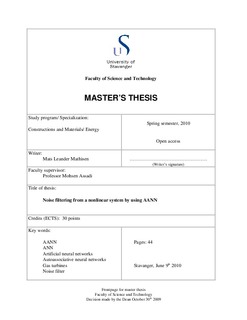| dc.description.abstract | In order to run a gas turbine, the operator (be it human or
automatic) needs to monitor the conditions of the various
parts inside it. Pressures, temperatures, mass flows,
vibrations, power output. These properties all need to be
controlled in order to run the gas turbine optimally. And
in order for the operator to make the necessary
adjustments, sensors inside the gas turbine are needed to
monitor said properties.
As the industry drives towards higher efficiencies and
lower emissions, the accuracy of these sensor readings
inside the gas turbine become more and more important.
The objective of this thesis then, was to see how this
accuracy could be improved by the use of autoassociative
neural networks (AANN), which is a kind of noise filter.
Sensor readings will not be completely accurate, since
the technology is not perfect. One problem is something
called random noise, meaning sensor measurements that
are scattered randomly close to the exact value. A noise
filter will take these scattered measurements and move
them all closer to the exact value.
It is already known that an AANN can perform this task,
and in this thesis the main objective was to find some
indication of just how effective it is as a noise filter.
In order to measure how effective a noise filter is, one
would ideally need one set of measurements, which are
noisy, and one set of corresponding measurements, which
are not noisy at all (perfect measurements). Checking the
level of noise reduction then would be to first filter the
noisy measurements, and then comparing both the
filtered and noisy measurements to the perfect
measurements.
Such a solution can not be found with real measurements
from a gas turbine, because they are never perfect. But if
the measurements were calculated using thermodynamic
and physics equations, they would not contain noise.
They would be completely theoretical, but they would not
contain noise.
Synthetic measurements like these were generated by the
use of a software which can model gas turbines and
calculate theoretical properties for various theoretical
scenarios. Noise was then added to these noise free
measurements in order to emulate the real gas turbine. And with that, two sets of measurements were available:
One set of noisy measurements, and one set of perfect
measurements.
With the use of the MATLAB neural network toolbox,
these sets of measurements were used to test the
effectiveness of an AANN as a noise filter. The noisy
measurements were filtered through an AANN, and the
filtered and noisy measurements were then compared to
the perfect measurements.
Artificial neural networks (ANN), which also have some
noise filtering abilities, were also tested this way. But not
as extensively as the AANN.
Results showed that there was indeed noise reduction, but
not for all the individual parameters in the measurements.
For some parameters, the AANN achieved very good
noise filtering, but for other parameters there was no
effect.
The reason for this is not entirely clear, but earlier two
purely mathematical examples were tested in order for the
author to familiarize himself with the methodology. And
these examples only had twothree
parameters; few
enough to visualize in graphs (2and
3 dimensional).
In these two examples, there was found a trend which
suggested that an AANN does not filter each parameter
individually, but rather all parameters together as if they
were one.
The author can not prove this, but he speculates the same
principle could apply to measurements that have more
than three parameters as well, which means that an
AANN might not be very ideal for noise filtering of
individual sensors inside a gas turbine.
It the future, it could certainly be interesting to test an
AANN on measurements from a real gas turbine. Several
conditions would need to be met for such a test to prove
useful; like extensive correlations between the different
parameters included, and redundant measurements. But it
is not unreasonable to assume there would be some reduction of noise. | no_NO |
